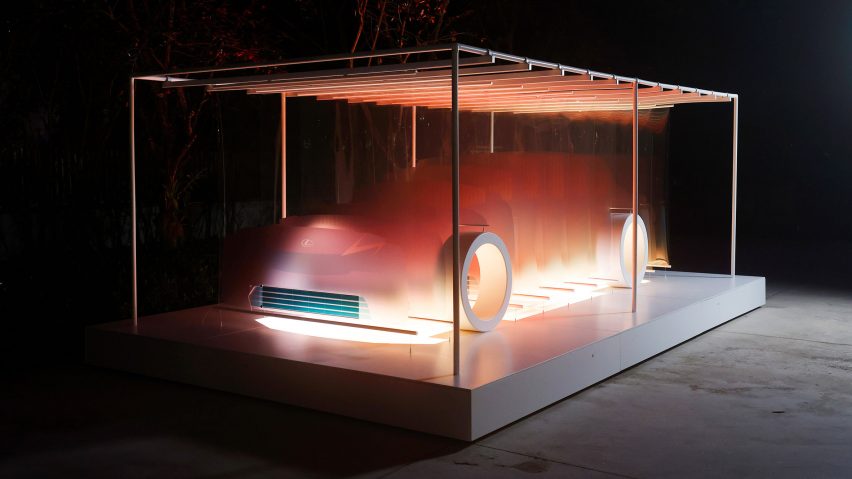Designer Marjan van Aubel has created an "interpretation" of an electric Lexus model using a series of multicoloured, illuminated photovoltaic sheets for Miami art week.
Located at the Institute of Contemporary Art, Miami (ICA Miami) and created in collaboration with Lexus and spatial experience design studio Random Studio, the installation generates power to contribute to an integrated audio and visual display.
The installation's title – 8 Minutes and 20 Seconds – references the time the sun's light takes to reach the earth's surface, as an homage to the star.
It consists of translucent polyethene terephthalate (PET) plastic sheets suspended from an overhead canopy, printed with succeeding sections of a car profile atop a white bamboo base. Four white, steel circles representative of wheels surround the sides.
The bamboo base of the installation covers a battery and is representative of the electric platform of the Lexus LF-ZC, a Battery Electric Vehicle (BEV) model which is currently under development.
Aubel told Dezeen her intention was not to create a fully solar-powered installation but rather to display the potential of how photovoltaic materials might be integrated into design and art.
"It was the idea that solar can be aesthetically integrated in a new way," Aubel told Dezeen. "The idea that it can be beautiful, hopeful and it's not only a technology but it should be intertwined in our daily life much more."
A panel of organic photovoltaic (OPV) cells are integrated at the bottom of each sheet, while the surrounding blue-hued shape is non-active.
Aubel has previously worked with OPVs in installations like her solar tapestry RA.
The third-generation solar technology works by printing light-absorbing ink in thin layers onto PET plastic, covering nanoparticles of titanium oxide that convert the captured sunlight into electricity.
It creates a flexible, translucent and coloured material.
In Aubel's installation, power generated from the OPV sheets during daylight hours is stored in the battery hidden in its base, contributing to an integrated light and audio display that plays ambient car noises and music.
At night, multicoloured lights from the installation's base illuminate the sheets, changing them from cooler hues in the day to warm reds at night.
The interactive, animated display was created using motion sensors.
"When you approach the installation, it recognizes your presence," said Aubel. "And it notices you're there so it gives you an electric sort of animation, like a ripple effect, and to me, it sounds kind of like it's a living car."
Aubel admitted she doesn't know the percentage of power that the OPV sheets contribute to the animated effects, and that it's not "fully self powering" but that wasn't the intent.
"Miami is a very nice platform to do this," said Aubel. "We see a lot of art, a lot of design, but I go to these solar panel fairs, and I just see numbers and payback time and stuff like that."
"The bridge between those worlds for me is difficult to make, so you have to speak to both worlds. We're not gonna change the world by numbers. We need to change our mentality."
Marjan van Aubel studio recently created a pavilion shaped like a giant beach chair and topped with multicoloured solar panels in collaboration with V8 Architects for Dutch Design Week 2022.
The photography is by Steve Benisty.
8 Minutes and 20 Seconds is on display at the ICA Miami in Miami, US from 6-17 Dec 2023. See Dezeen Events Guide for an up-to-date list of architecture and design events taking place around the world.

